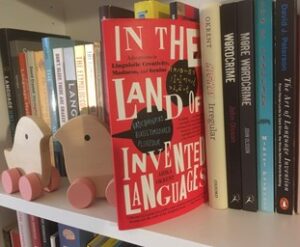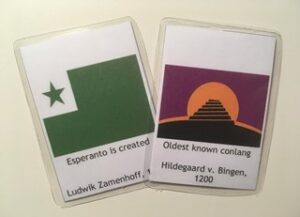Not so long ago, I was a stranger in a particularly strange land. The land was that of invented languages, and my guide was Arika Okrent, linguist and professional writer. My ticket was a bright red paperback with zany white lettering on the front. The journey lasted just over 800 years – the length of the recorded history of invented languages. Or perhaps that was the destination rather than the journey? I seem to have reached the outer border of this metaphor, so let’s cross over to a more tangible overview of Okrent’s book.

In the Land of Invented Languages was released in 2009 and is 293 pages long. The book is the result of five years of research into conlangs, but what Okrent has done involves much more than simply reading up on her topic of choice. One of the first things I noticed about the writing was that, although Okrent makes good use of her linguistic expertise, the tone didn’t feel much like a linguist sharing their knowledge about language. Rather, the book felt like a piece of highly engaging journalism, and I think that’s in large part due to Okrent’s personal immersion into the social circles of conlanging. The book describes her research process, which included going to conventions, interviewing friends and family members of influential conlangers, and even personally attaining a first-level certification in Klingon. Okrent gives the reader a strong sense of her own gradual immersion into the eponymous land, making herself at once the seasoned expert and the newcomer whose wide-eyed curiosity channels the reader’s own.

Okrent presents us with a gallery of fascinating characters up through the ages, all of whom – for one reason or another – end up creating their own languages. We start with the twelfth century’s Hildegaard von Bingen, who is by all accounts a remarkable character even when discounting the language invention. I mentioned her when discussing this book with my historian father, who – despite not having known about her role in the history of conlanging – recognised her from, among many other things, her role in inventing modern beer. Hildegaard, a Benedictine abbess, claimed that the mysterious language in which she wrote was of divine origin, and that it had been revealed to her in a vision.
From religion we move on to philosophy, as intellectuals of the seventeenth century set out to describe the relationships between everything in the known universe. Obviously, natural languages are all too puny and limited for something like that, so they decide to create their own languages based on complex taxonomies. This eventually leads them deep into the darkest alleys of semantic discussion, where they promptly have their metaphorical wallets stolen by the inconvenient reality that language simply cannot correlate objectively to the real world – no matter how carefully invented it is.
We then move to Ludwik Zamenhof’s hopes for global peace and equality, embodied in his home-cooked language Esperanto, which would go on to become the most widely spoken conlang in the world. We visit Charles Bliss and his vainly altruistic Blissymbols, as well as Marc Okrand with his legions of Klingon-speaking sci-fi fans. Okrent devotes a series of short chapters to each of a handful of selected conlangs, but includes myriads of other conlangs and snippets of historical context whenever relevant. Gradually, the reader comes to view conlanging as a kind of technology: Over time, it is refined by different people, used with different aims, taking many different forms, but always at its core the same basic idea. Like a lightbulb, or a telephone, or the wheel – if lightbulbs, telephones and wheels were intrinsically built into the human mind, that is.

But as is the case with any telling of events, Okrent is not just giving us a history, but a narrative. In this case, the narrative is about a series of individuals who feel drawn to take on a cause that’s noble and idealistic, but invariably doomed. Okrent portrays these people with a great dose of sympathy, but also with a sense of pity at what most of them hoped – and failed – to achieve with their creations. In the final chapter, Okrent notes that it is ironic for Klingon to be one of the world’s most succesful conlangs, since it has “no purpose” compared to the likes of Wilkins’ Philosophical Language (a language supposed to facilitate greater understanding of the world) or Blissymbols (a language in which it was supposed to be impossible to lie). Here, I must respectfully disagree. Okrent treats Klingon with a lot of respect, as I imagine any certified speaker of the language would, so my grievance here is nothing more than a matter of wording. And yet, the pedant in me needs to let it out: To say that Klingon has no purpose is just wrong. It was made to entertain – just as it is in fact doing, abundantly. I think this division between conlangs “for fun” and “for a purpose” is a strange one to make, but I can also see that, intentionally or not, the division serves Okrent’s narrative of the Conlanger as a strangely sympathetic Sisyphus.
The same is true of another marked decision in making this book. The one person I would expect to have their own chapter in any book about the history of conlanging is J. R. R. Tolkien, who codified an entire literary genre mostly in order to provide a context for his own conlangs. Okrent, however, relegates Tolkien to a couple of mentions in the final chapter, and my guess is that this is because he doesn’t fit the narrative described above. Conlangs whose only purpose is to exist for the sake of the intrinsic fascination they inspire – how do you fit those into a story about the struggles of solitary conlangers versus the harshness of reality?
But now I feel that I’m being awfully critical about a book that I really do like. In reality, I’m glad we got chapters about Charles Bliss and James Cooke Brown instead of Tolkien, if only because Tolkien is already so well-known as a conlanger, and finding information about him is not difficult at all. So given the choice, I’d rather learn about Loglan and its unique controversies, and I’m glad that’s what Okrent decided to spend her time on; even if I’d also love to read her take on the stories behind Sindarin, Quenya and the other languages of Middle-Earth.
Another thing I’d love to see Okrent’s take on is what happened next. As mentioned, the book was released in 2009, and is a generally thorough chronicle of conlangers leading up to that point. But that same year saw the release of the sci-fi movie Avatar, and with it Paul Frommer’s widely popular conlang Na’vi. Two years later, the TV series Game of Thrones began airing, housing multiple conlangs created by none other than David J. Peterson, who happens to be visiting Aarhus University’s Linguistics department at this very moment . Peterson has since made a big name for himself as the entertainment industry’s “Go-To Linguist” – a title which Okrent’s book bestows upon the Klingon creator Marc Okrand. Wouldn’t you know, now there are two of them!
In short, conlanging has seen a big boost in popularity in the past thirteen years, both as a popular hobby and as a part of larger media projects. Personally, I think there’s great potential for an extra chapter in future releases of this book, detailing all those conlangs made simply for the joy of it. In fact, I suspect I’d enjoy Okrent’s writing on most topics, which is also why her new book, Highly Irregular, is waiting right now on my bedside table.
In The Land of Invented Languages is very fun and approachable, and I would recommend it to anyone who thinks they might be just a little bit interested in its topic. The early chapters in particular contain a number of schematics, and there are grammatical examples throughout the book, but don’t let the level of detail scare you away. With or without total comprehension of the linguistic features described, what the reader will find is a captivating story about the lives of history’s conlangers, as well as what became of their efforts. You don’t need a degree to understand it, and you don’t need to be a conlanging nerd yourself. But after reading this book, you might want to become one.
Gustav Styrbjørn Johannessen is an MA student of Linguistics at Aarhus University, and is currently doing an internship with the Danish Language Council. He has been known to dabble in conlanging, and will eventually create a complete language of his own. He is also a member of SOLIA, the Student Organisation of Language Invention Aarhus.








1 thought on “Book Review: ‘In the Land of Invented Languages’ by Arika Okrent”